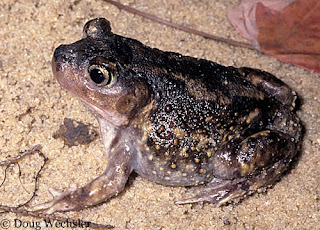True Wild Life | Spadefoot Toad | There are two main types of spadefoot toad, those that live only in North America and those that live in Europe, Northern Africa and Western Asia. The spadefoot toad is an amphibian and anurans. Anurans are frogs and toads. Spadefoot toads are rarely seen because of their unusual habits. They are usually found in Western North American deserts like the Mojave, Chihuaha, and Sonoran. Normally this would be a problem for an amphibian, but spadefoot toads are able to deal with the hot and dry weather as spadefoot toads spend most of their time underground.
The spadefoot toad is a burrowing species of toad and they use their large front feet to make tunnels in the sand. Spadefoot toads are able to spend weeks underground but will come to the surface at night time after heavy rain when the air is moist, so that they can feed. Spadefoot toads are omnivorous animals and have a primarily vegetarian diet when they are young. As the spadefoot toad gets older, they begin to eat large invertebrates such as snails, grasshoppers and caterpillars.
The spadefoot toad tadpoles develop very quickly. They can also dig holes and bury themselves until the next desert rain, when they will spawn and turn into the larger, rounder adult toads.
Spadefoot toads generally live between 3 and 12 years but are prey to a number of larger predators. Birds and birds of prey can pick out an unsuspecting spadefoot toad from the sky above and snakes often hunt them on the ground. Fish are the primary predators for the smaller and more vulnerable spadefoot toad tadpoles.




No comments:
Post a Comment